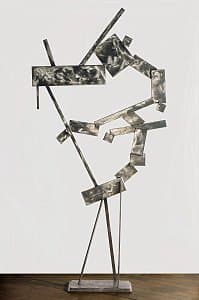

David Smith
Learn more25 planes 1958
© David Smith. VAGA/Copyright Agency Purchased 1978
More detail | PermalinkDavid Smith’s works, the earliest welded steel sculptures made in the United States, reveal his background training as an artist and in the trades: he is the sculptor who drew with metal.[1] From the late 1940s, as he ‘thinned the traditional mass of sculpture’, Smith ‘opened his work to the world around it, using space as his “canvas”’.[2] A scholarship, awarded by the Guggenheim Foundation in 1950 and 1951, allowed Smith to focus more exclusively on his sculpture, and he began to work in series at this time, many designed to be displayed outdoors. The Unities, finished in June 1962, were followed by Voltri; they, as well as the following Cubis series, some of his best-known works, also feature ‘scumbled’ stainless steel surfaces designed to glint in the light.
25 planes 1958 is the fourth work in Unities, a series of at least 11 closely-related sculptures fabricated in stainless steel, characteristically consisting of rectangular planes composed in a very ‘two-dimensional’ arrangement.[3] In a special edition of the magazine Arts devoted to Smith, the artist stated that he began the Unities series in 1957, conceiving the stainless steel pieces for ‘bright light, preferably for the sun, to develop the illusion of surface and depth’.[4] Identified by the number of planes in the work,[5] 25 planes is an array of flat metal shapes welded together around two hollow spaces, radiating up and out from the long and thin props that hold them aloft. It’s as if the shapes are frozen in time ‘after an explosion in a moment of transitional instability, the tiny thin strip hanging on the other side being an unpromising counterweight’.[6]
It seems likely that Smith’s adoption of stainless steel as a medium in 1957 determined the basic characteristics of the group. The stainless steel was much harder to cut than the metal he had used previously, so he ordered pre-cut plates in an assortment of basic geometric shapes from his suppliers, Ryerson Steel Fabricators. This restriction provided the simple repertoire of squares and rectangles used in the Unities. Cautious with the new material, Smith would lay out the elements on a flat surface to determine the final arrangement, then weld them together. The arc welder used to join the metal plates left a deposit that had then to be ground away, a fact that may have encouraged the artist to make a feature of the circular scouring of the surface of the planes. When 25 planes is lit, the scouring of the stainless steel planes creates a myriad of reflective scribbles and scuff-marks across the surface of the planes, highlights that alter when the light shifts or the viewer moves even slightly, creating as Smith desired, ‘the illusion of surface and depth’.[7] The surface treatment of 25 planes emphasises the role of drawing in the artist’s working process, both as preparation for work in three dimensions or as means of ‘loosening’ the hand, or indeed as ‘sometimes what sculpture is, sometimes what it can never be’.[8]
Lucina Ward[9]
[1] Before moving to New York in 1926, Smith had studied at Ohio University and worked in the Studebaker factory in South Bend, Indiana; ‘David Smith – the sculptor who drew with metal’, at http://au.phaidon.com/agenda/art/articles/2013/february/15/david-smith-the-sculptor-who-drew-with-metal/, accessed 6 April 2018.
[2] Joan Pachner, David Smith, Phaidon Press, London, 2013, p 55.
[3] Others from this series include: Sentinel II 1957, Hirshhorn Museum and Sculpture Garden, Washington, DC; Fifteen planes 1958, Seattle Art Museum; and Two box structure 1961, Philadelphia Museum of Art.
[4] David Smith, ‘Notes on my work’, Arts, vol 34, no 5, February 1960, p 44.
[5] David Smith, interview with Katherine Kuh in The artist's voice: Talks with seventeen artists, Harper and Row, New York, 1962.
[6] ‘David Smith: 25 planes 1958’ in Ron Radford (ed), Collection highlights, National Gallery of Australia, Canberra, 2014, p 338.
[7] Smith, ‘Notes on my work’, p 44.
[8] Carmen Giménez et al, David Smith: A centennial, Guggenheim Museum, New York, 2006, p 408.
[9] Adapted and updated from Michael Lloyd and Michael Desmond, European and American Paintings and Sculptures 1870–1970 in the Australian National Gallery, Australian National Gallery Canberra, 1992, pp 295–7, by Steven Tonkin and Lucina Ward.

